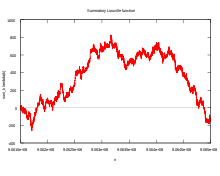Guess by Pólya


The Pólya conjecture refers to a presumption of the mathematical field of number theory . It says that the majority of natural numbers are numbers with an odd number of prime factors up to an arbitrarily specified limit . The conjecture was made in 1919 by the Hungarian mathematician George Pólya , but refuted in 1958. The Pólya conjecture is an example of the fact that a mathematical statement that applies to numerous small numbers can nevertheless be entirely wrong due to a (relatively large) counterexample.
statement
More precisely, Pólya's conjecture says the following: For a given natural number ( ), divide the natural numbers from 1 to and including into two sets, namely those with an odd number of prime factors on the one hand and those with an even number of prime factors on the other. Then the first of these two sets contains at least as many numbers as the second. Here, multiple occurring prime factors are also correspondingly counted multiple times, so that, for example, has an even number of factors, namely piece, whereas three, that is to say has an odd number of factors. The 1 does not have a single prime factor, so it has an even number.
Alternatively, the conjecture can also be formulated with the help of the summatory Liouville function and then states that
applies to all . It is positive when there are many prime factors and negative when there are an odd number. The omega function gives the number of prime factors of a natural number.
refutation
In 1958, CB Haselgrove proved for the first time that Pólya's conjecture was wrong by showing the existence of a counterexample .
A first explicit counterexample, namely 1960 R. Sherman Lehman gave ; Minoru Tanaka found the actually smallest counterexample in 1980.
Pólya's conjecture does not apply to most in the range 906.150.257 to 906.488.079. The Liouville function increases here to positive values of up to 829 (for ).
Web links
- Eric W. Weisstein : Polya Conjecture . In: MathWorld (English).
Individual evidence
- ↑ G. Pólya : Various remarks on number theory . In: Annual report of the German Mathematicians Association . 28, 1919, pp. 31-40.
- ↑ CB Haselgrove: A disproof of a conjecture of Pólya . In: Mathematika . 5, 1958, pp. 141-145. doi : 10.1112 / S0025579300001480 .
- ^ RS Lehman: On Liouville's function . In: Mathematics of Computation , Vol. 14, No. 72, 1960, pp. 311-320, doi: 10.2307 / 2003890 , JSTOR 2003890
- ↑ M. Tanaka: A Numerical Investigation on Cumulative Sum of the Liouville Function . In: Tokyo Journal of Mathematics . 3, No. 1, 1980, pp. 187-189. doi : 10.3836 / tjm / 1270216093 .













